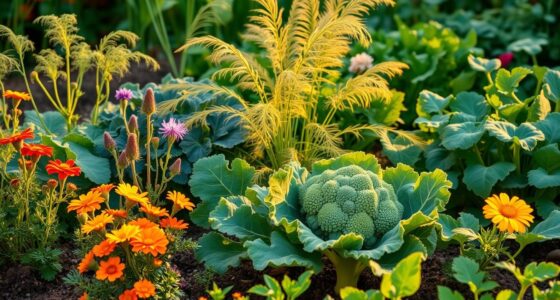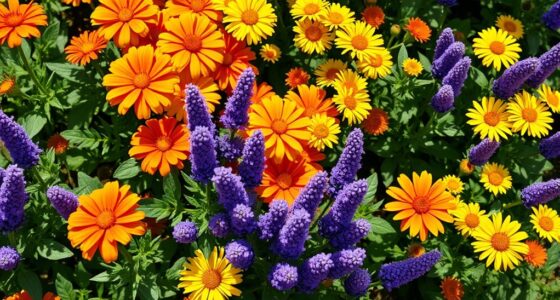To boost your coneflowers, combine them with native grasses like little bluestem, and attractive perennials such as black-eyed Susan for vibrant color. Incorporate herbs like basil and oregano to support growth and deter pests. Plant pollinator favorites like lavender or milkweed to attract bees and butterflies. Add ground covers like creeping thyme for soil health, and tall plants like goldenrod for vertical interest. For more ideas, discover how to create a thriving, balanced garden around your coneflowers.
Key Takeaways
- Native grasses like little bluestem and switchgrass create a natural backdrop and attract beneficial insects.
- Pair coneflowers with complementary perennials such as black-eyed Susan and lavender for continuous bloom and vibrant color.
- Incorporate herbs like basil, oregano, and chamomile to support coneflower growth and deter pests naturally.
- Add pollinator-friendly plants like bee balm and milkweed to attract pollinators and enhance garden productivity.
- Use ground covers like creeping thyme and sedum to reduce weeds, fill gaps, and support ecosystem health.
Native Grasses That Complement Coneflowers
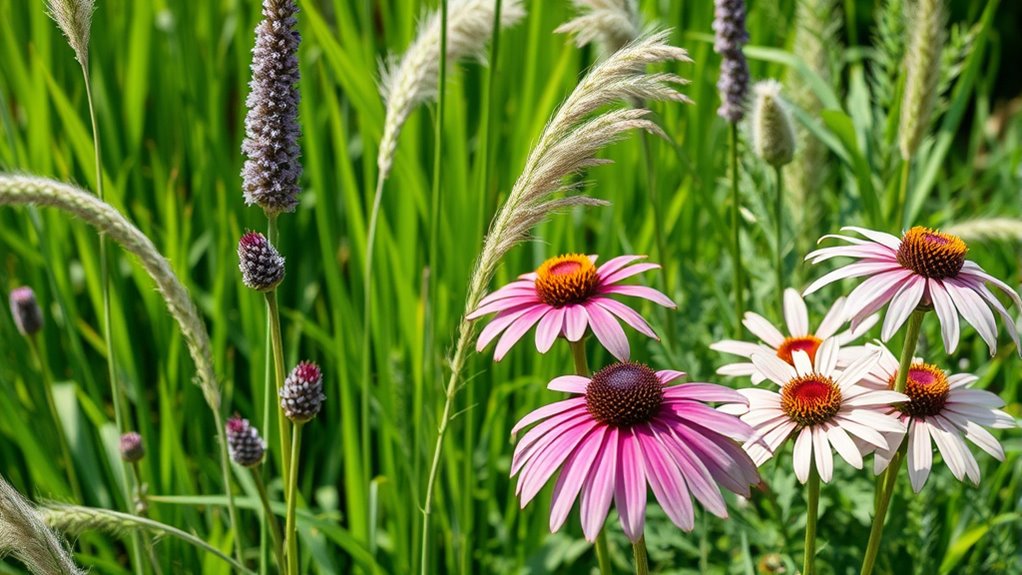
Native grasses make excellent companions for coneflowers because they add texture and movement to your garden while requiring minimal maintenance. These grasses, like little bluestem or switchgrass, create a natural backdrop that highlights the vibrant petals of coneflowers. Their fine blades and airy seed heads sway in the breeze, giving your garden a dynamic feel. Native grasses are well-suited to local soil and climate conditions, making them easy to grow and maintain. They also help reduce weed growth by filling empty spaces and stabilizing soil. Incorporating native grasses can also promote biodiversity by attracting beneficial insects and supporting local wildlife. Additionally, native grasses are adapted to local environmental conditions, ensuring they thrive with less watering and care. Combining coneflowers with native grasses results in a low-effort, aesthetically pleasing landscape that attracts pollinators and supports local ecosystems. This pairing offers a natural, elegant look that’s both resilient and easy to care for.
Attractive Blooming Perennials to Pair With Echinacea
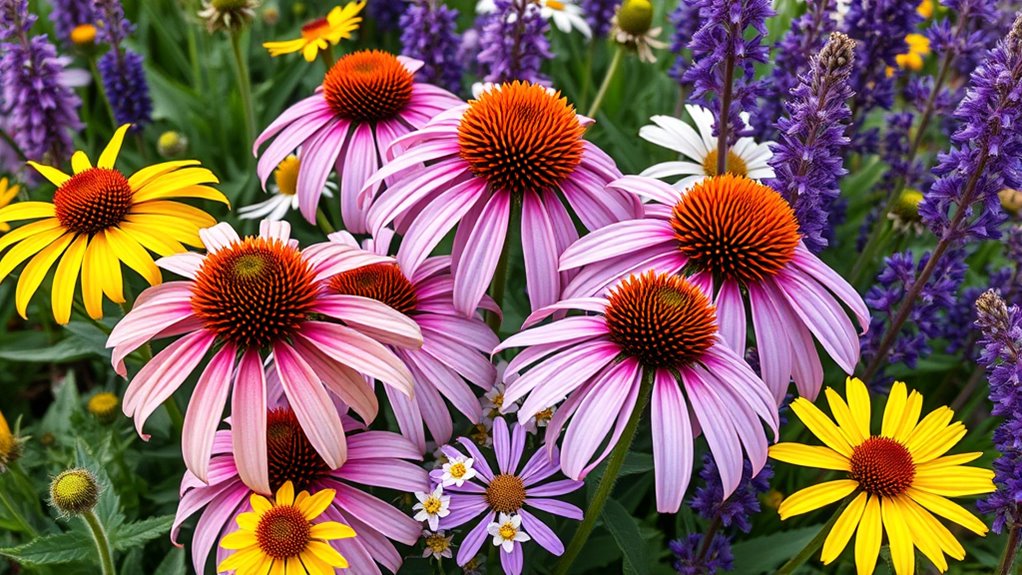
When choosing perennials to pair with Echinacea, consider flowers that complement its colors for a harmonious look. You’ll also want plants that bloom at different times to keep your garden vibrant throughout the season. Combining these elements creates a dynamic, eye-catching display that lasts. Incorporating plants with color accuracy ensures the hues remain vivid and true to nature. Selecting plants with compatible growth habits can help create a cohesive and balanced garden design. Additionally, selecting plants that support garden organization can make maintenance easier and more enjoyable. Incorporating plants that promote well-being can also enhance the garden’s overall ambiance, making it a peaceful retreat.
Complementary Flower Colors
Pairing coneflowers with flowers in complementary colors can create a vibrant and visually striking garden. Bright yellows like coreopsis or black-eyed Susan add warmth and energy, making your garden feel lively. Cool blues and purples from salvia or lavender provide a calming contrast that enhances coneflowers’ bold pinks and purples. Rich oranges, such as blanket flower or crocosmia, create a fiery display that catches the eye and sparks excitement. These color combinations evoke feelings of happiness, tranquility, and inspiration, turning your garden into a mesmerizing sanctuary. By thoughtfully selecting flowers with complementary hues, you can craft a balanced, harmonious landscape that invites admiration and joy from every angle.
Blooming Time Coordination
To create a garden with continuous blooms, it’s essential to select perennials that flower at different times but complement echinacea’s peak season. By staggering bloom times, you ensure your garden stays vibrant from early spring to late fall. For example, plant early bloomers like Siberian iris, mid-season favorites like black-eyed Susan, and late bloomers such as goldenrod. Here’s a quick guide:
| Early Bloomers | Mid-Season Bloomers | Late Bloomers |
|---|---|---|
| Siberian Iris | Black-eyed Susan | Goldenrod |
| Bleeding Heart | Shasta Daisy | New England Aster |
| Creeping Phlox | Coreopsis | New York Aster |
| Lungwort | Yarrow | Ironweed |
This coordination guarantees your garden remains colorful and lively throughout the growing season.
Beneficial Herbs That Support Coneflower Growth
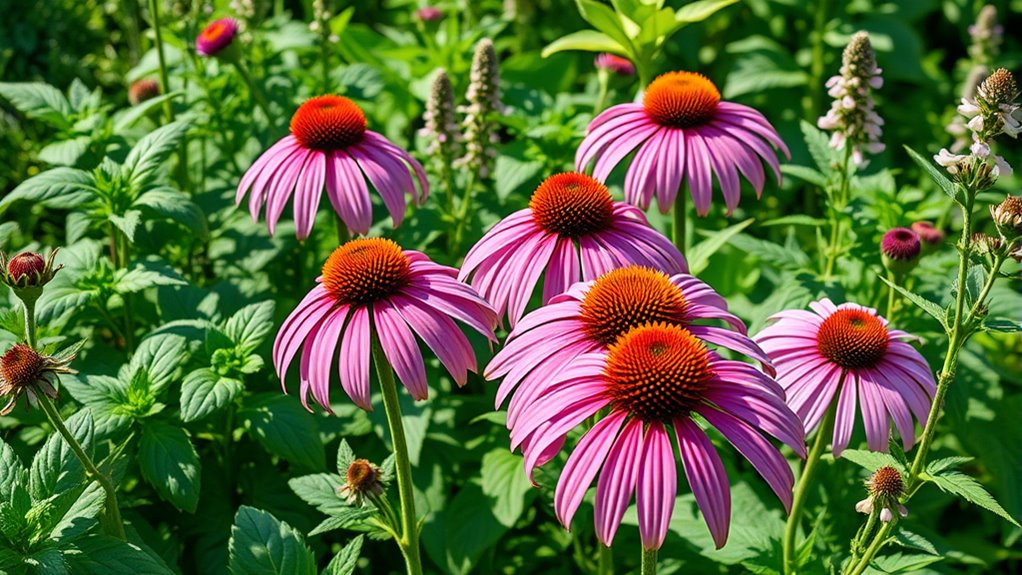
Ever wondered which herbs can boost your coneflower’s health and essentialness? Incorporating certain herbs can strengthen your plants and enhance your garden’s vigor. Here are three top choices:
- Basil – Its natural antibacterial properties help keep coneflowers healthy by deterring pests and preventing disease. Additionally, filtration systems in your garden tools or watering systems can help keep the environment cleaner for your plants. Proper soil management also plays a crucial role in maintaining healthy coneflowers, as it influences nutrient availability and plant resilience.
- Oregano – This hardy herb improves soil health and repels insects, creating a safer environment for your coneflowers to thrive.
- Chamomile – Known for its calming effects on plants, chamomile promotes growth and strengthens coneflowers against harsh weather. Enhancing soil health through companion planting can further support your garden’s overall vitality.
Companion Plants That Attract Pollinators
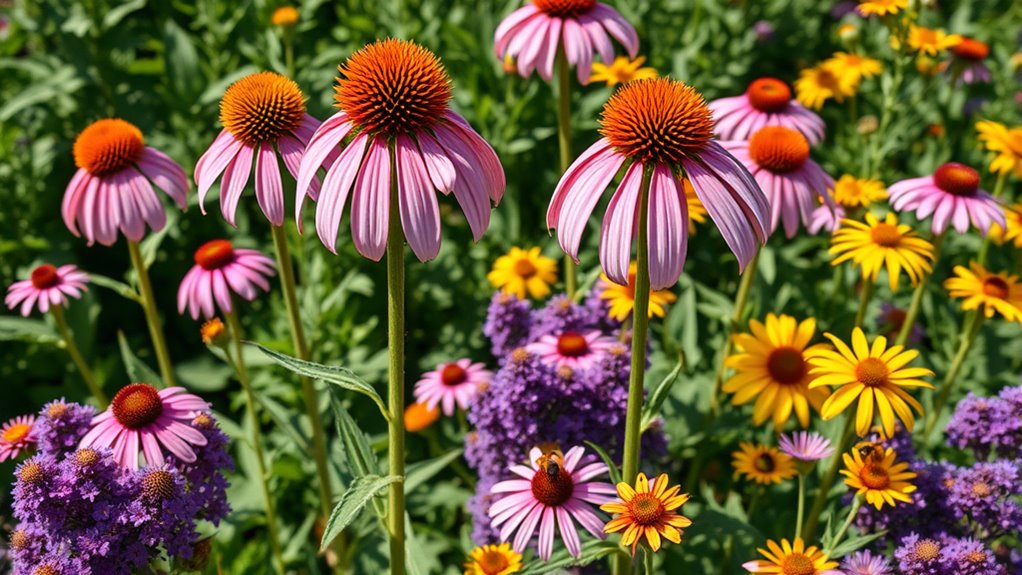
Attracting pollinators to your coneflowers is essential for boosting their bloom quality and overall health. By planting certain companion plants nearby, you create a welcoming environment for bees, butterflies, and other pollinators. Bright, nectar-rich flowers like bee balm, lavender, and milkweed draw these helpful insects to your garden. These plants not only provide food but also serve as visual cues, guiding pollinators toward your coneflowers. When pollinators visit, they transfer pollen, boosting seed production and encouraging more vibrant blooms. To maximize attraction, choose plants that bloom throughout the growing season. Keep your garden free of pesticides, and provide a variety of flowers to ensure a steady supply of nectar and pollen, creating a thriving pollinator habitat that benefits your coneflowers and overall garden health. Understanding best anime movies can inspire you to incorporate visually stunning plants that enhance your garden’s appeal. Additionally, selecting plants that support AI-powered environmental monitoring can help maintain a balanced and healthy garden ecosystem. Incorporating pollinator-friendly plants can significantly improve the vibrancy and resilience of your garden environment. Planting a diverse array of nectar-rich flowers also supports pollination efficiency, leading to healthier and more abundant coneflowers. Creating a habitat rich in native plants encourages local pollinators to thrive and continue supporting your garden year-round.
Shade-Tolerant Plants for Partial Sun Coneflower Spots
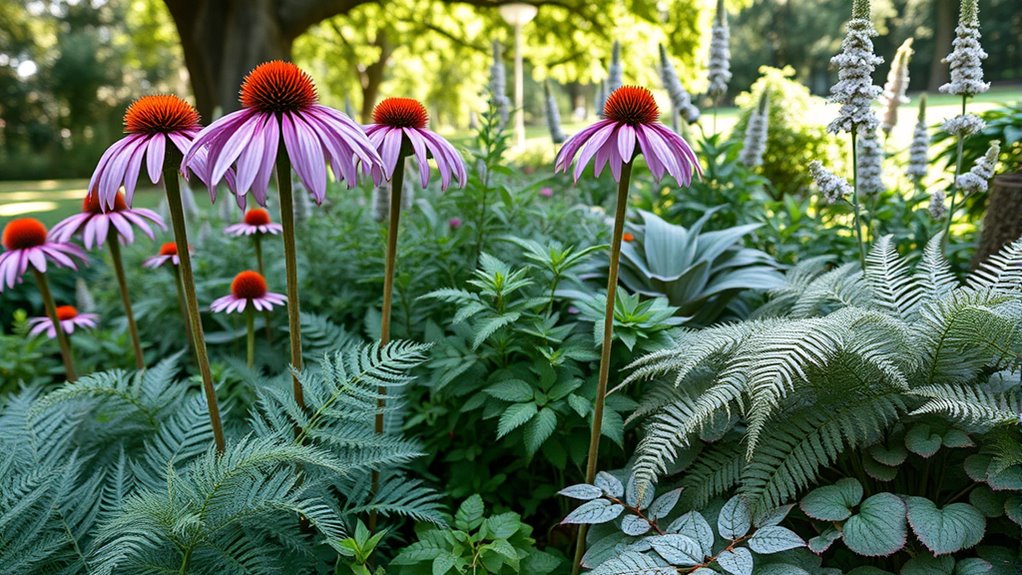
When planting coneflowers in areas with partial sun, consider adding suitable understory plants that thrive in shade. Shade-loving ground covers can fill in gaps and reduce weeds, while flowering options that tolerate less sun add color and interest. These choices create a balanced, vibrant garden even in shaded spots. Incorporating visualization techniques can help you stay motivated and aligned with your gardening goals.
Suitable Understory Plants
Shade-tolerant understory plants thrive beneath coneflowers, creating a layered and diverse garden. These plants flourish in partial sun, filling your space with texture and color. Choosing the right understory plants can evoke a sense of harmony and tranquility. Imagine a lush, vibrant garden where each plant complements the other. Here are three excellent options to contemplate: Foamflower (Tiarella cordifolia) – Its delicate, frothy blooms add elegance and attract pollinators. Wild Ginger (Asarum canadense) – With heart-shaped leaves, it provides rich ground cover and natural beauty. Toad Lily (Tricyrtis spp.) – Its unique, exotic flowers bring a touch of intrigue and wonder. Additionally, understanding the role of plant symbolism can deepen your appreciation for these selections and enhance your garden’s thematic harmony. Incorporating knowledge of asset division can also help gardeners plan for future landscape changes or property considerations, ensuring a sustainable and harmonious garden space. Proper soil preparation and plant compatibility are essential to help these shade-loving plants establish successfully. Integrating AI-driven insights can assist in selecting plants that thrive under similar conditions, increasing your garden’s overall success. These plants will thrive in shaded spots, enriching your garden’s depth and appeal.
Shade-Loving Ground Covers
Adding shade-loving ground covers to your garden beneath coneflowers can transform bare spots into lush, vibrant patches. These plants thrive in partial sun or dappled shade, making them perfect companions for coneflowers in less sunny areas. Consider options like sweet woodruff, which spreads easily and adds a fresh scent, or creeping Jenny, with its bright yellow-green foliage that brightens shaded corners. Hosta varieties also work well, offering textured leaves that contrast nicely with coneflowers’ bold blooms. These ground covers help suppress weeds, retain moisture, and add visual interest at ground level. Incorporating halal-friendly gardening practices ensures your garden remains aligned with ethical and cultural values. Plant them around your coneflowers’ base, ensuring they get enough shade and water. Using local ingredients in your garden can promote sustainable and culturally respectful planting. With these choices, you’ll create a lush, low-maintenance understory that complements your coneflowers beautifully.
Complementary Flowering Options
In areas where coneflowers receive only partial sun, pairing them with other flowering plants that thrive in similar light conditions can enhance your garden’s visual appeal. Choose plants that bloom during different times to extend color and interest throughout the season. These combinations create a vibrant, inviting space that captures attention and sparks joy. For example, consider:
- Black-eyed Susan (Rudbeckia) – Bright yellow blooms add warmth and contrast, energizing your garden.
- Coreopsis – Cheerful, daisy-like flowers bring a splash of sunshine and complement coneflowers’ structure.
- Shasta Daisy – Elegant white petals create a crisp, fresh look, harmonizing beautifully with coneflowers’ purple tones.
These choices fill your garden with life, making it a welcoming, colorful retreat. Incorporating best flowering plants suitable for partial sun ensures a sustained display of color and vitality throughout the growing season. Additionally, selecting plants that are adapted to shade can further improve the longevity and health of your garden design.
Low-Growth Ground Covers for Echinacea Gardens
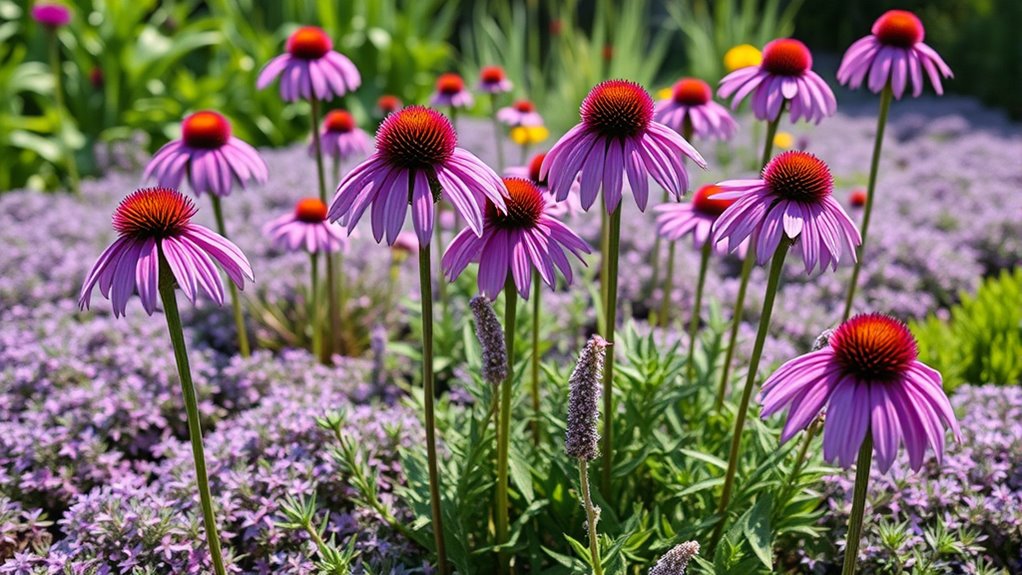
Low-growing ground covers are an excellent way to enhance your echinacea garden by suppressing weeds and adding visual interest at the front of beds. These plants create a lush, continuous mat that keeps the soil moist and prevents weed growth. Consider options like creeping thyme, which releases a pleasant aroma when stepped on, or sedum varieties that offer succulent foliage and vibrant flowers. Irish moss provides a soft, lush green carpet, perfect for filling in gaps without overpowering your coneflowers. Ajuga offers attractive foliage and purple flower spikes, adding contrast. When choosing ground covers, guarantee they tolerate similar sunlight and soil conditions as your echinacea. Properly selected ground covers not only beautify your garden but also reduce maintenance and soil erosion. Incorporating native regional plants can further support local ecosystems and attract beneficial pollinators.
Tall Plants That Provide Vertical Interest and Support
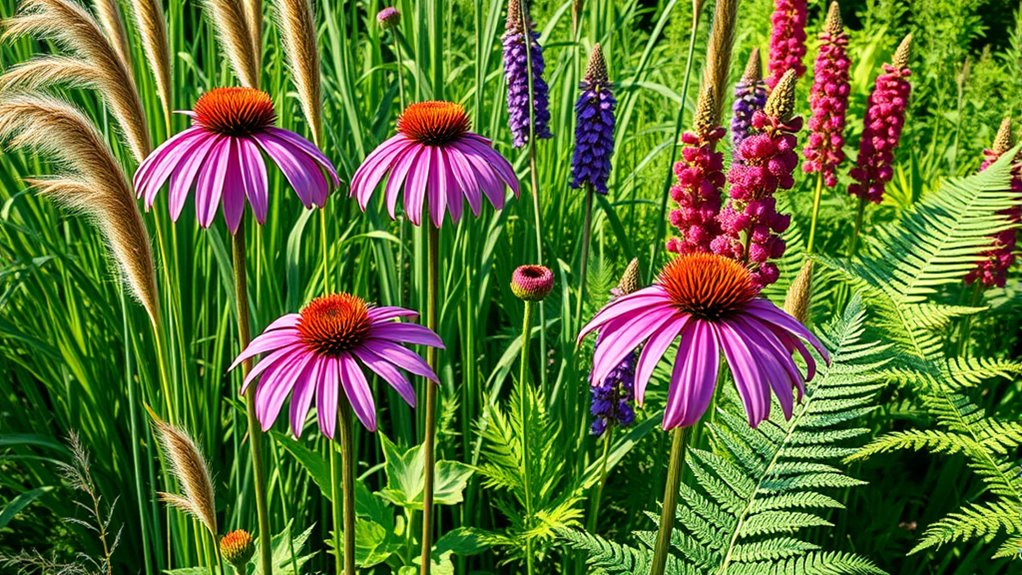
Tall plants can elevate the visual appeal of your echinacea garden by providing vertical interest and natural support. They draw the eye upward, creating a dynamic, layered landscape. Plus, they help keep your coneflowers upright, especially in windy conditions.
Tall plants add vertical charm and natural support, making your echinacea garden vibrant and resilient.
Consider these standout options:
- Joe-Pye Weed – Its towering clusters add drama and attract pollinators, making your garden lively and vibrant.
- Goldenrod – Bright, tall, and cheerful, it complements coneflowers while offering essential habitat for beneficial insects.
- Sunflowers – Their bold stature and cheerful blooms bring a joyful energy, making your garden feel alive and inviting.
These plants not only support your coneflowers but also create a stunning, multi-dimensional display.
Companion Plants That Deter Pests From Coneflowers
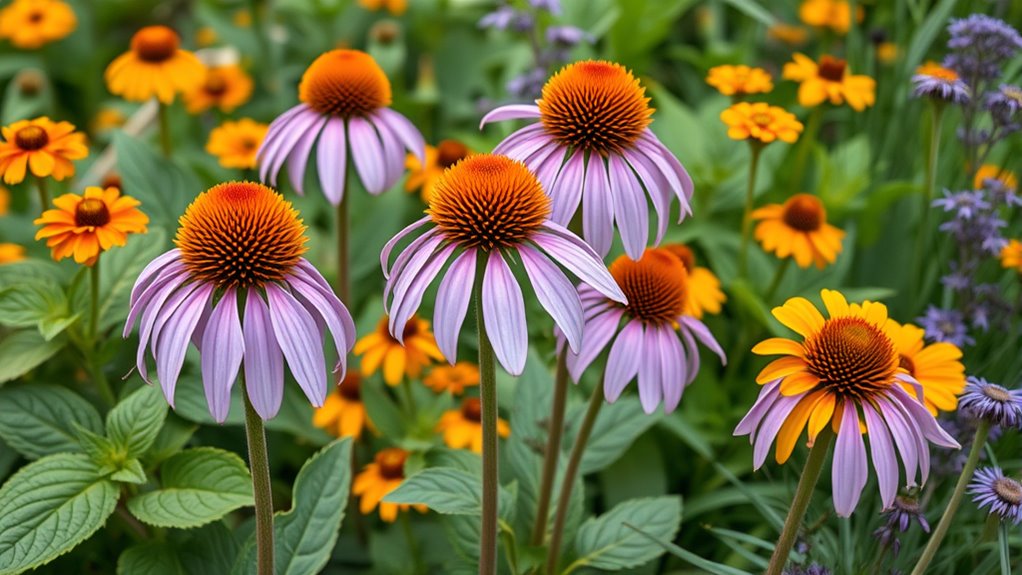
To protect your coneflowers from pests, choosing companion plants with natural repellents is highly effective. Plants like marigolds emit strong scents that deter aphids, nematodes, and beetles. Basil, when planted nearby, can repel thrips and mosquitoes while also enhancing flavor if you grow herbs. Chrysanthemums contain pyrethrins, natural insecticides that ward off a variety of pests. Feverfew and tansy are also excellent choices, as their aromatic foliage repels whiteflies, ants, and other unwanted insects. Incorporating these plants into your coneflower bed creates a natural barrier, reducing the need for chemical treatments. Plus, many of these companions attract beneficial insects like ladybugs and lacewings, which help keep pest populations in check. This strategy promotes a healthier, more resilient garden ecosystem.
Easy-to-Grow Vegetables and Herbs to Incorporate in Echinacea Beds
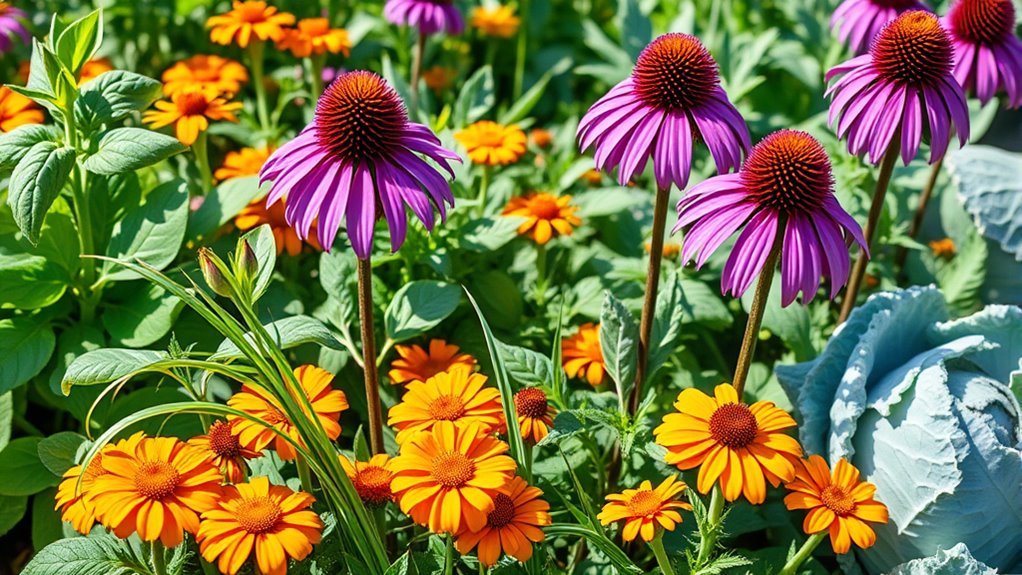
Incorporating easy-to-grow vegetables and herbs into your coneflower beds not only boosts your garden’s productivity but also creates a vibrant, multifunctional space. You’ll enjoy fresh flavors and a more dynamic landscape. Consider planting these three companions:
- Basil – Its aromatic leaves repel pests while adding a fragrant touch to your garden.
- Lettuce – Grows quickly and stays low, filling in gaps without overshadowing your coneflowers.
- Chives – Their mild onion scent deters insects and offers a beautiful, edible border.
These plants thrive alongside coneflowers, requiring minimal effort and enhancing your garden’s beauty and functionality. With each harvest, you’ll feel more connected to your garden’s bounty while supporting healthy, thriving Echinacea beds.
Frequently Asked Questions
How Do Companion Plants Improve Coneflower Health and Vitality?
Companion plants boost coneflower health and vigor by creating a balanced garden environment. They can help attract beneficial insects that pollinate or ward off pests, reducing the need for chemicals. Additionally, they improve soil quality, retain moisture, and provide shade or wind protection. When you plant compatible companions, you enhance coneflower growth, encourage blooming, and promote resilience, making your garden more vibrant and healthy overall.
Are There Specific Companion Plants to Avoid Planting Near Coneflowers?
You might think any plant can be neighbors, but some can cause chaos in your garden. Avoid planting aggressive, invasive species like mint or ivy near coneflowers—they’ll smother your delicate blooms in a relentless takeover. Also, steer clear of plants with fungal diseases or those that attract pests that prey on coneflowers. Keeping these in check guarantees your coneflowers flourish without being overshadowed or sickly, creating a vibrant, healthy garden.
Can Edible Herbs Be Grown Alongside Coneflowers Without Competition?
Growing edible herbs alongside coneflowers generally works well, as long as you choose herbs with similar sunlight and watering needs. You can plant herbs like basil, thyme, or chives nearby without much competition, since they won’t overshadow the coneflowers. Just guarantee you space them properly and monitor watering, so neither plants become stressed. This way, you enjoy a vibrant, functional garden with both beautiful and edible plants thriving together.
What Are the Best Strategies for Balancing Aesthetics and Plant Compatibility?
Imagine your garden as a symphony, each plant a essential note. To balance beauty and compatibility, choose plants with similar sunlight and water needs, like a harmonious chorus. Use varying heights and colors to create visual interest without crowding. Space your plants thoughtfully, like dancers on a stage, ensuring each gets its moment to shine. This approach transforms your garden into a lively, balanced masterpiece of nature.
How Does Soil Type Influence Companion Planting Success With Coneflowers?
Soil type plays a vital role in your planting success. If your soil is well-draining and rich in organic matter, coneflowers thrive and support healthy growth. Sandy soils prevent waterlogging, while loamy soils retain moisture and nutrients. You should tailor your companion plants to match your soil’s characteristics, ensuring they all flourish together. Proper soil conditions enhance plant compatibility, making your garden look vibrant and healthy.
Conclusion
By choosing the right companion plants, you can turn your coneflower garden into a vibrant, thriving haven. With a bit of planning, you’ll create a symphony of color, support pollinators, and keep pests at bay—all while making the most of your space. Remember, a well-connected garden is like a well-oiled machine, so don’t be afraid to experiment and let your plants work together to bring your landscape to life.



